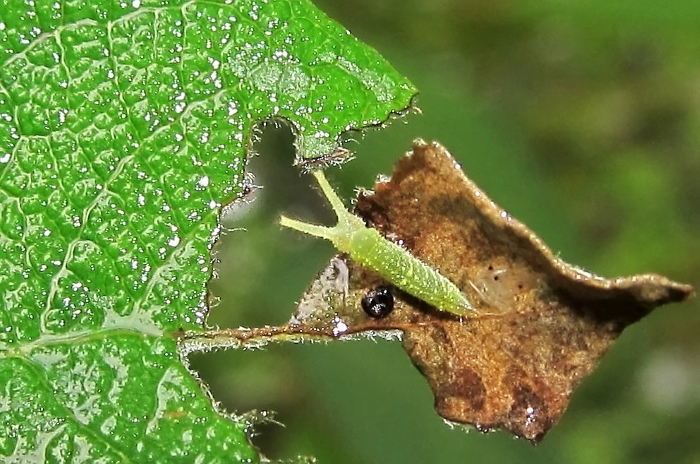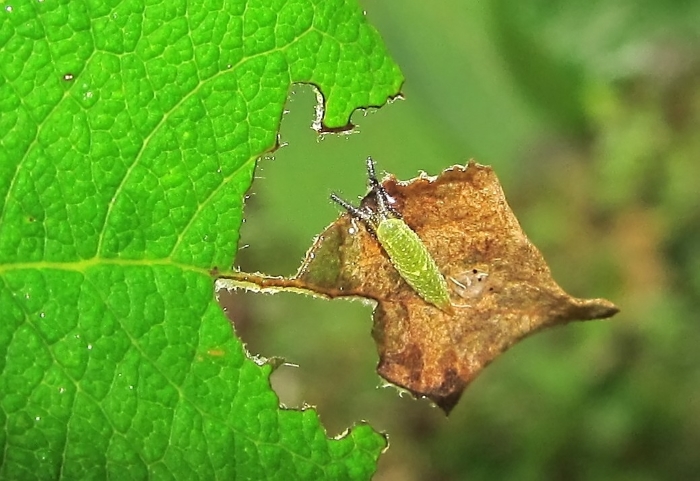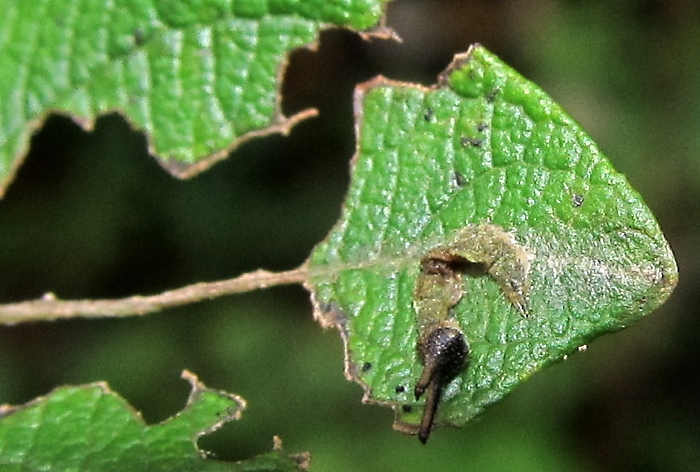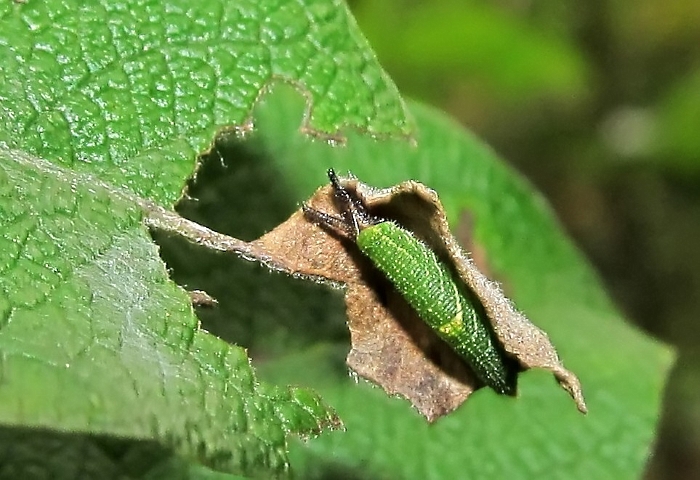Page 89 of 220
Re: Padfield
Posted: Thu Aug 14, 2014 7:43 pm
by David M
I'm already feeling great affinity for these caterpillars. I hope they survive, but they have months of dangerous moments ahead.
Re: Padfield
Posted: Thu Aug 14, 2014 8:12 pm
by Pauline
Fascinating insight into the lives of these little cats Guy - who would have thought they could survive all that rain

As usual, magnificent scenery and very spectacular rainbow shots - love it!
Re: Padfield
Posted: Thu Aug 14, 2014 9:00 pm
by Padfield
Thank you, Andy, David and Pauline.
What chance do they have of surviving, David? Assuming a 99% loss from egg to reproductive adult (figure based on a female laying 200 eggs, of which one male and one female on average need to survive in order to replace her and her mate), the probability of one or more individuals making it out of 12 eggs laid is 1 - 0.99^12 = 0.11. It's difficult to adjust this figure as time goes by because mortality is not uniform over the 11 months of a purple emperor's immature life; but basically, the odds are stacked against any of these surviving to adulthood. That said, I knew Aurelian from an egg to the day he wandered off to pupate (though I missed out on his entire 2nd instar), and he was the only caterpillar I followed that year. Sītā is at the same location where Aurelian grew up, which is also where Trajan lived (and he flew!!) so if location affects mortality maybe my odds are better. So far, one of the 12 is known to be deceased and one has gone AWOL, possibly deceased.
They serve their species just by trying - of the thousands of eggs laid throughout the forest, enough will survive to keep purple emperors going. But they serve me if they reach 2nd instar! I have dozens if not hundreds of photos of each of the other instars but at present just one of 2nd instar. That was Tiberius, who then himself immediately went AWOL and returned in 3rd instar. One of the reasons I am following these cats so closely now is to see if I can document a complete 2nd instar and the transition to 3rd.
What effect might the cold and wet have had, Pauline? It will be interesting to see how much longer the 1st instar of these cats is, compared with that of Tiberius, who lived out his 1st instar in good weather. He shed his skin on the morning of day 14. That would correspond to this coming Saturday for Brahmā, the first-born, and his consort Sarasvatī, born a few hours later.
Guy
Re: Padfield
Posted: Fri Aug 15, 2014 9:16 am
by Padfield
One day ahead of schedule, Brahmā entered 2nd instar today. Because it was raining, Minnie refused to go for her usual early walk and we didn't get off until after 09h30, as the rain stopped. When we reached his site, Brahmā was just completing the skin change. You can see his skin at his tail and his head capsule, visible just as a black crescent, still stuck to his face. His horns are soft and curved as they have just been released from the shoulder pack:

I didn't try for better photos as this is a sensitive time and I didn't want anything to go wrong. When I passed again, on my way back home, he was free of his head capsule, which you can see on the leaf beside him, and his horns are now straight:

Guy
Re: Padfield
Posted: Fri Aug 15, 2014 3:16 pm
by Padfield
Later in the rain - I mean, later in the day - Brahmā's head and horns coloured up, so he now looks like a normal 2nd instar cat:

He hasn't got a wonky horn - it's just refraction, caused by water droplets:

Otherwise, no changes in eggs or cats - just lots of watery wombs. This is Sītā:

Guy
Re: Padfield
Posted: Fri Aug 15, 2014 9:20 pm
by essexbuzzard
Have to say,Guy,that i am loving this sequence of PE caterpillar images. Keep them coming.Sounds like you are having a summer like we had in 2012. Next you'll be telling us that there is fresh snow on the highest ground...in August!
Re: Padfield
Posted: Fri Aug 15, 2014 9:23 pm
by David M
Agreed. Superb reportage as ever, Guy.
I'm looking forward to further instalments.
Re: Padfield
Posted: Sat Aug 16, 2014 6:41 am
by andy brown
Keep them coming Guy great pics and reports as usual and at this rate we will have a sub species "aqua iris"

Andy
Re: Padfield
Posted: Sun Aug 17, 2014 3:08 pm
by Padfield
I had to be in Lausanne in the morning and Villars in the evening today, so had no opportunity to take advantage of the rare sunshine that reigned for most of the day. But of course I took Minnie for her walks, and so checked up on the
iris cats.
Hanumān and Varuṇa are missing, presumed dead. Rāma, Lakṣmaṇa, Brahmā, Sarasvatī and Sītā are all fine and on their usual leaves. Sarasvatī and Rāma look ready to change skins soon. This is Rāma:

Here is Brahmā, the only one currently in 2nd instar:

Of the remaining eggs, one more has hatched - Sugrīva, the monkey king. He was eating his egg when I found him in the early afternoon:


The last three eggs, apparently still alive - but who knows? - are all heads-up.
Guy
Re: Padfield
Posted: Tue Aug 19, 2014 8:55 am
by Padfield
I couldn't leave home on Sunday, because of commitments, so first thing on Monday morning Minnie and I headed to the Engadine, for a last ditch go at
Melitaea asteria. We've been waiting since the beginning of July for a good time to do this but rain has stopped play.
We reached Thusis (722m) at about 11h30 and immediately took the most direct, walkable route to the site I had chosen to explore, at about 2100m (I deliberately didn't ask for site information because I much prefer looking for things myself - and it is public information the species flies near Thusis). We walked up in blazing heat and Minnie was just brilliant. As we neared 2000m,
tyndarus,
pronoe and
gardetta became prominent and when we got to my chosen site everything looked perfect - except the weather. It suddenly turned very cold, cloudy and windy. I spent some hours exploring alpine tundra between 2000m and 2300m, seeing hardly anything at all except half-torpid
tyndarus, a single, very worn
pales and in one very brief, sunny patch, a female
eros - something I've never photographed before. So, no
asteria.
We found a good place to sleep, under a larch in a meadow at about 1860m, and Minnie spent her first night up a mountain. At first, she heard the call of the wild and sat outside, drinking in the sounds and smells of night. Or perhaps she was guarding me - or just wondering when we were going home. But then the clouds cleared and it became the most beautiful, bitterly cold, clear night, so she came into the bivvy bag and curled up next to me. Every time I woke up I stuck my head out of the bag and watched the procession of Milky Way constellations swimming by - Cygnus, Cassiopeia, Perseus, Auriga - dazzlingly set in the gleaming Milky Way. The sky had a wonderful depth and brilliance - no light pollution at all - not even a mountain hut or refuge in the distance to detract from the stars.
And then in the morning the clouds bubbled up again, so we headed back down the mountain. Before we reached Thusis it was raining. When I get back home I'll post a few pictures, but not of
asteria, sadly!
Phone picture, uploaded from the train:

Guy
Re: Padfield
Posted: Tue Aug 19, 2014 6:17 pm
by David M
That all sounds positively idyllic, Guy (especially for Minnie, who must have loved every minute).
Shame about missing out on your target species but there were plenty of compensations.

Re: Padfield
Posted: Tue Aug 19, 2014 7:33 pm
by Padfield
It was quite magic, David. I didn't get away camping and bivvying in Spain this year, so it was actually my first night under the stars of 2014. I'm very glad it didn't rain, though. Bivvy bags are fine in the rain, but bivvy bags with wet dogs in them probably aren't.
Here are a very few pictures (I didn't take many).
The first is a battle-scarred
pronoe on the way up. I was so keen to get to the top quickly I didn't take advantage of the large numbers of this species beginning to gather on the track in the early afternoon:

This is that female
eros.

There was a strong wind and she wouldn't open her wings except on my hand, nor settle anywhere except deep in grass.

This next (I believe) is
tyndarus. There were lots of perfectly normal tyndarus around - it was by far the commonest butterfly I saw - but this one was distinctly different:

This is the kind of habitat I was exploring:

You can't see it in that picture, but those clumps are heather, which I thought would be a good nectar source for
asteria.

Don't be deceived by the blue sky in that first picture, either! Facing the other way it was like this:

As I said, the night was clear, but clouds started drifting across the sky by about 04h30 - I was hoping to get a glimpse of the conjunction of Venus and Jupiter but it was not to be. We got up at sunrise:

Minnie thought perhaps we should go back to bed:

FINALLY,
I checked the
iris cats this evening. Sugrīva, who hatched on Sunday, is nowhere to be seen and his egg leaf is uneaten. I think he has perished. Two new cats have emerged. I decided to name these after good demons, so they are Trijaṭā, a demoness who counsels Sītā, and Vibhīṣaṇa, whom Rāma finally crowned king of Laṅkā, in place of his evil half-brother Rāvaṇa.

(Trijaṭā)

(Vibhīṣaṇa - he was deep in shade and not very accessible)
Sarasvatī is now in second instar:

Rāma is still first instar, as is Sītā, though she is growing that lumpy saddle that will become the horns:

Guy
Re: Padfield
Posted: Wed Aug 20, 2014 2:05 pm
by Padfield
Finally, I'm beginning to find first and second instar white admiral cats. I'm sure now I've got my eye in I will find them all over the place.
Here is a first instar cat:

It is a really tiny creature - probably just 2mm long.
These are second instar:


I might take my tripod down to the woods one day to get better pictures - it's really not easy, handheld in the shade.
The caterpillar on the left in this next picture (the same one as in the picure above) has worked with the central vein of a honeysuckle leaf. The one on the right, which is hidden under the leaf, is using a side-vein.

Little change with the
iris cats. A few photos:

(Brahmā)

(Sītā)
The two newborns found yesterday were still alive today:

(Trijaṭā)

(Vibhīṣaṇa)
Not far away, some forest bugs, allies of the evil demon Rāvaṇa, were indulging in a threesome:

Let us hope the female lays her eggs somewhere else.
Guy
Re: Padfield
Posted: Wed Aug 20, 2014 3:51 pm
by Pauline
What a great report Guy and I am very envious of your adventures. Minnie is one very lucky little dog


Re: Padfield
Posted: Sat Aug 23, 2014 4:04 pm
by Padfield
I'm a very lucky man too, to have been given her, Pauline!
I'm getting behind on writing up at the moment, as things are busy. I did another high trip a couple of days ago, which will have to wait for the moment, but I can quickly summarise the caterpillar situation at least.
Of a dozen
iris eggs found, ten have hatched, one was sucked dry and the last one has been heads-up so long I am sure it is dead.
I thought I'd lost three caterpillars to predation - Sugrīva, Hanumān and Varuṇa. Today, though, I definitely found Varuṇa and possibly found Hanumān. He's a clump of leaves away from where Hanumān was born but I know for certain Hanumān isn't on his birth clump and I thought I'd checked the other clump for eggs. I'm calling him Hanumān, anyway. If I'm wrong, it will distort the stats a little, but it would if I erred the other way too.
Rāma, Sīta, Brahmā and Sarasvatī are all in second instar. Here is Sīta today:

She hatched on 8th August, so spent just over two weeks in first instar. She never changed leaves and I don't think she's moved more than a few centimetres in her life. This is Sīta on the day she was born:

Finally, a couple of pictures showing the same
camilla cat 24hrs apart, showing just how much he ate in that time:


Guy
Re: Padfield
Posted: Tue Aug 26, 2014 6:30 pm
by Padfield
The wettest July since the Jurassic limestone of the Alps lifted out of those prehistoric seas has been followed by the wettest August I can remember. I haven't got the Météosuisse report on August yet but I expect it to include a few records (low temperature, low sunshine, high precipitation - or maybe all three). This morning Minnie flatly refused to go on a walk because of the torrential rain, so I had to check on the
iris cats on my own. It didn't stop raining until the late afternoon, when she grudgingly agreed to get her precious paws wet and I did a second inspection.

The morning's photos were all of submerged cats. This is Varuṇa (god of waters and the oceans...):

Not far away was Sarasvatī (whose name means, 'abounding with lakes'):

Vibhīṣaṇa looked oddly refracted ...

... but he was entire under all that water:

Trijaṭā just looked miserable:

When I went back later she was a little more perky and apparently setting off to get a bite to eat:

Sītā is now long enough (6-7mm - though I should probably use imperial with
iris ...) for her horns to stick out of her raindrop:

Brahmā can't quite fit inside his either:

I also found a new caterpillar today. He was in the same neck of the woods as Sarasvatī and Varuṇa so I named him Indra, chief of the gods and the god of rain and thunderstorms. The Sanskrit for rainbow is
indradhanus (
iris is Latin and Greek for rainbow). Here he is:

A breeze started moving the twig as I took that picture, but Indra seems to have been mostly unmoved by it.
It wasn't just the
iris cats that had to contend with the weather. This is a second instar
camilla cat:

And I think there is a first instar
camilla cat in here, but I couldn't tell ...


Guy
Re: Padfield
Posted: Thu Aug 28, 2014 6:22 pm
by Padfield
It was unexpectedly sunny yesterday and today, though there is definitely an autumn feel to things now. With the change of weather, some of the
iris cats moved from their original leaves. I haven't found them all yet but those that are still alive should make their new location known by their feeding pattern. Rāma, sadly, will feed no more. Something got him:

Nearby on the same leaf was this creature:

I have no idea what that second insect is, or whether it could be responsible for Rama's demise.
On a more positive note, here is the new cat, Indra, looking vibrant:

After fixing yet another puncture, I dropped down to the valley this morning with Minnie to check up on the cardinals and look for brown hairstreaks. The cardinals are apparently well established now. I saw several males and a couple of females at the usual site, then sat in the shade at a quarry not far away just to watch things coming and going. Two male cardinals dropped down from the mountain and crossed in front of me. I saw a further individual about two kilometres away, just before I cycled home again. It is amazing to be able to watch this fantastic butterfly in the Rhône Valley whenever I want, from May to September - something unthinkable just a couple of years ago.
I didn't even try to move in close on any cardinals - the males in particular were zooming all over the place in their quest for world domination. Here are just record shots of a male and a female, taken from some distance:


These days, I prefer just to watch them.
I did get close, though, to a male brown hairstreak, that came to ground while I was sitting in the shade:

That is the first male I've photographed in Switzerland.
Elsewhere, in high winds, a couple of females were checking out some blackthorn. Because of the wind they stayed in the middle of the bushes and I couldn't get close but I got a blurry shot of one of them (sitting on some other plant growing among the blackthorn, before someone protests!):

Other new species for the year - mainly because I simply haven't been out in July and August - were tree grayling and purple hairstreak.
Guy
Re: Padfield
Posted: Thu Aug 28, 2014 9:52 pm
by David M
Another noteworthy reportage 'in the raw'.
Clearly, these cats are going to have a tough time over the next few months.
You've done well to identify a decent number, Guy, as my feelings are that many/most/all of them will perish.
Good luck in your quest.
Re: Padfield
Posted: Fri Aug 29, 2014 9:45 am
by Jack Harrison
I had never before seen photos of caterpillars inside blobs of water. I hadn't know such a thing was possible.
I must ask you Guy: "Have you made a new discovery?"
Jack
Re: Padfield
Posted: Sat Aug 30, 2014 5:37 pm
by Padfield
Yess, David, most of them will perish before they get a chance to fly. My dream remains to follow an individual from egg to adult in the wild without intervention - I've come close in the past but the odds are against it.
I doubt I've discovered anything new, Jack, but I'm glad to have brought this phenomenon to wider attention. It's clear that by adopting their position at the tips of leaves or on the protuding mid-vein, purple emperor and white admiral cats maximise their chances of immersion, in both rain and dew. This serves to hide them and possibly protect them from would-be predators, as well as preventing them from drying out - a significant danger for such a tiny ceature. They make no attempt to move out of their watery bubbles.
At lunchtime today, even though it hadn't rained since yesterday, white admiral cats in the shade were still holding their droplets. This is a first instar cat:

Varuṇa moulted into second instar this morning. His head capsule was on the leaf beside him when I walked past the first time but had fallen off by the time I returned:

This is Indra:

I don't know how long the second instar lasts. Brahmā has been at this stage for just over two weeks now but has not yet adopted the 'praying' posture of a caterpillar laid up to moult. This was him yesterday - day 15 of the second instar:

Guy



























































